Waste Management and Land Reclamation
KMG’s production activities lead to the generation of production wastes, such as: drilling wastes (waste drilling muds and cuttings), oily wastes (bottom sediments, oil-contaminated soil, oil sludge), waste catalysts and chemical reagents.
All facilities also generate waste from ancillary activities such as construction waste, oily rags, waste lubricating oil, etc.
KMG strives to strictly comply with the principles of the state environmental policy in the field of waste management, as well as the implementation and enforcement of the principles of KMG’s Environmental Policy in relation to waste management:
- Ensure that waste generation is reduced and managed safely.
- Apply a set of waste recovery technologies that prevent secondary contamination of soil, air or water resources.
- Introduce resource-saving, low-waste, environmentally friendly technologies
Waste generated at the facilities is collected separately at the initial stage of generation, generated waste is weighed on weighing equipment, for liquid waste the volume of waste is measured in standardised or graduated containers.
All KMG facilities keep records of waste by type, quantity and properties.
The results of waste record keeping are submitted to the authorised body in the field of environmental protection, as well as to the KMG HSE information system.
From the moment of waste generation, waste is accumulated, disposed of or sent for recovery and/or removal by own forces or with the involvement of dedicated companies.
Dedicated companies involved in waste recovery or removal must have all necessary permits:
- Licence for treatment, neutralisation, recycling and/or disposal of relevant hazardous waste.
- Notification of commencement of collection, sorting and (or) transportation of waste, recovery and (or) disposal of relevant non-hazardous waste.
- Environmental permit.
To reduce the impact of waste during transportation, KMG SDEs have established requirements for dedicated companies to minimise the movement of waste or its recovery within KMG SDEs.
Work on the recovery of newly generated and previously accumulated waste by dedicated companies is controlled by KMG SDEs for compliance with the technical specifications of the contract signed and the design solutions for waste recovery and removal, including visits to waste recovery facilities, if necessary control laboratory analyses of the recovered waste are carried out.
In 2023, KMG spent KZT 22.9 billion on recovery of generated and accumulated waste.
Work also continues on the disposal of historical oil waste and the clean-up of oil-contaminated land at MMG, OMG and KBM facilities under the Memorandum of Cooperation between the Ministry of Ecology, Geology and Natural Resources of the Republic of Kazakhstan and KMG dated 6 August 2019.
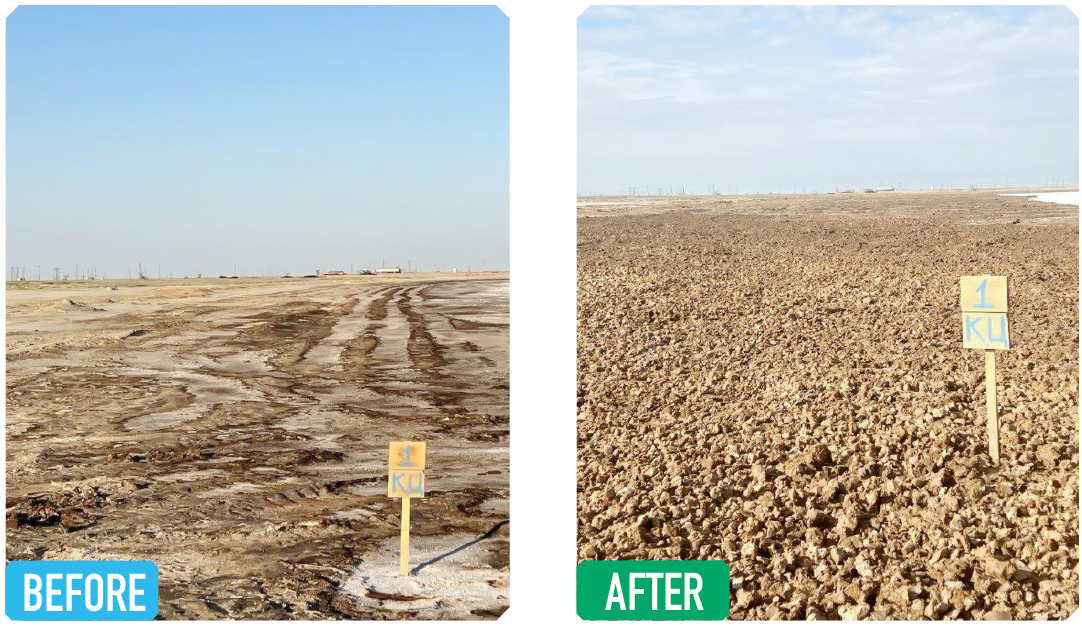 KC-1 – historical contamination site in EMG territory
KC-1 – historical contamination site in EMG territory
EMG also carry out works on elimination of historical contamination, in 2022 they completed works on cleaning of historical oil-contaminated land within the contract areas, works on elimination of historical contamination outside the contract areas in accordance with the reclamation project and the opinion of the State Environmental Expertise to it are being carried out.
A total of 1,145.04 thous. tonnes of historical wastes were disposed of in 2023, the areas of their disposal sites were rehabilitated, and work is underway to clarify the remaining volumes of historical oil wastes.
|
Waste composition (tonnes) |
Waste generated |
Waste sent for recovery |
Waste sent for removal |
|---|---|---|---|
|
Hazardous waste |
383,096.52* |
1,561,543.06** |
115.50 |
|
drilling waste |
228,355.8 |
228,355.8 |
-- |
|
Non-hazardous waste |
52,758.55 |
31,702.58 |
20,246.98 |
|
Total waste |
435,855.07 |
1,593,245.63 |
20,362.49 |
* – the amount of waste generated is presented taking into account the waste generation volumes of contractors performing work at the facilities of KMG SDEs.
** – taking into account historical waste disposal volumes as well as the previous year’s carryover volume.
Waste sent for recovery and removal (tonnes)
|
|
At the facilities of SDEs |
At the facilities of contractors |
Total |
|---|---|---|---|
|
Hazardous waste |
|
|
|
|
Waste recovery |
825,150.70 |
736,392.36 |
1,561,543.06 |
|
drilling waste |
-- |
228,355.8 |
228,355.8 |
|
Waste disposal |
115.50 |
-- |
115.50 |
|
drilling waste |
-- |
-- |
-- |
|
Non-hazardous waste |
|
|
|
|
Waste recovery |
2,241.20 |
29,461.37 |
31,702.58 |
|
Waste disposal |
929.11 |
19,317.87 |
20,246.98 |
|
Total |
1,613,608.12 |
||
RATIO OF DISPOSED WASTE AMOUNT TO NEWLY GENERATED WASTE AMOUNT(t/t)
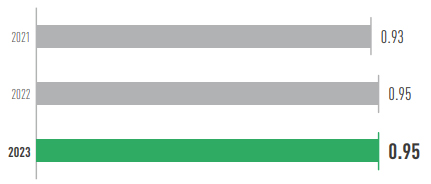
RATIO OF DISPOSED WASTE AMOUNT TO ACCUMULATED AND NEWLY GENERATED WASTE AMOUNT(t/t)
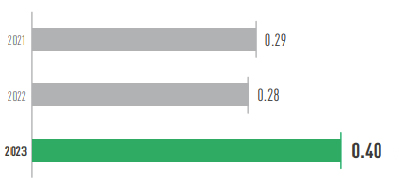
RATIO OF CONTAMINATED LAND AREA AT THE END AND BEGINNING OF THE YEAR(ha/ha)
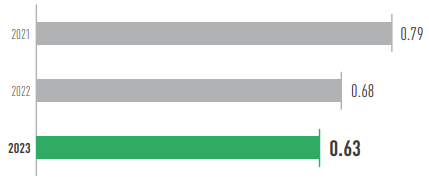
RATIO OF RECLAIMED LAND AREA DURING THE YEAR TO CONTAMINATED LAND AREA DURING THE YEAR(ha/ha)
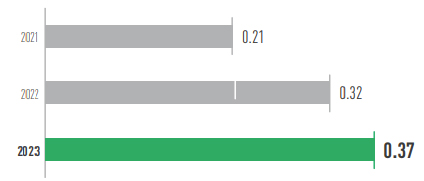
- ECOLOGY AND INDUSTRIAL SAFETY
- Our Management Approach
- Water Management Programme
- Environmental Protection
- Air Protection
- Sustainable Use of Crude Gas
- Waste Management and Land Reclamation
- Decommissioning and Reclamation of Work Sites
- Offshore Well Control
- Oil Spill Prevention and Response
- Biodiversity Conservation and Support of Specially Protected Natural Areas
- Environmental Management Training of Personnel
- Environmental Assessment of Planned Economic Activities
- Public Organisation Engagement
- Green Office Concept in KMG
- Occupational Health and Safety
- Contractor Engagement
- Occupational health, safety, and hygiene
